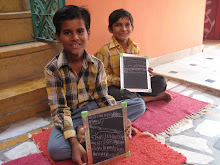There are large, powerful schools of American educational theory that state bluntly: Our schools are in a state of CRISIS. This bold pronouncement is usually backed up by mountains of data amounting to spelling the word 'CRISIS' with flashing red lights while the theme from Schindler's List plays on repeat. And it's not without merit. One in three students will never graduate from high school and rural and urban schools across the country have become 8am-3pm dumping grounds from poor students who aren't developing the schools to meet basic literacy and math standards.
This depressing shovel is one way to dig into the issue of education. At The Merasi School, we have tried another approach. The Merasi have enough pre-determined obstacles in their path - living on .25 cents a day, being born without birth certificates, assigned the social worth of pollution- that we'd get plenty of nowhere by focusing on what education they don't have.
So we turned the tables and decided to focus on what they can do, have and be with education. By shifting from a framework of deficits to a framework of assets, the possibilities explode infront of the students like cherry blossoms in the DC spring. In its best form, education nurtures the raw potential that each student brings into the classroom and ripens it into its fullest expression. It is a fundamentally hopeful undertaking. It's something to be -- to use a word rarely associated with America's public schools -- joyful about it.
Most absolutely, the American educational institution is in need of serious attention. But it will not sustainably emerge from painting headlines with terrifying statistics about underperforming schools. Rather, I think that constructive change will be the product of families, educators and students developing bone-deep excitement about what can and must exist inside the classroom.
Subscribe to:
Post Comments (Atom)



No comments:
Post a Comment